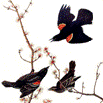Center, Internet, Wildlife Damage Management

Bird Control Seminars Proceedings
Document Type
Article
Date of this Version
October 1973
Abstract
It has been known for centuries that light (photoperiod) is possibly the major environmental stimuli affecting bird behavior and physiology. The length of the light period stimulates the breeding cycle, migration, fat deposition, and molt in most species of birds. Therefore, it is only natural that one would think of using light as a means of bird control. In fact, light has already been used as a bird control; flood-light traps have been used to trap blackbirds (Meanley 1971); Meanley states that 2000-W search lights have been used to alleviate depredation by ducks in rice fields. Pulsing light is already used on aircraft, aircraft hangers and high towers as a means of detourinq birds (Schaefer, 1968). With some positive results already obtained with light as a bird control, the next step is to see if a better light source (the laser) might not have a greater effect. The laser is basically an intense and coherent light with extreme directivity and, thus, might have greater influence on a bird’s behavioral and physiological responses.

